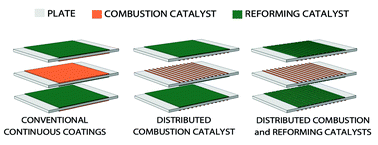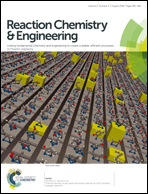Improved performance of a catalytic plate reactor coated with distributed layers of reforming and combustion catalysts for hydrogen production
Abstract
Performance of a catalytic plate reactor coated with different patterns of distributed layers of reforming and combustion catalysts is investigated for the endothermic methane steam reforming (MSR) coupled with the exothermic methane combustion to produce hydrogen. To simulate MSR, an experimentally validated surface microkinetic model for a nickel-based catalyst is implemented in reforming flow channels. Required thermal energy to the MSR sites is supplied by catalytic and gas-phase methane combustion (MC) carried out in the neighbouring parallel flow channels. To simulate combustion reactions, a reduced surface microkinetic model for the catalytic MC and power rate model for the gas-phase MC are implemented in combustion flow channels. The study considers two-dimensional domains for the coating layers of reforming and combustion catalysts and identifies the internal-diffusion limitations for the reforming-catalyst coating thicker than 50 μm and for the combustion-catalyst coating thicker than 5 μm. Results obtained for different patterns of distributed coatings of reforming and combustion-catalysts are evaluated against the results obtained for conventional continuous coating layers by comparing temperature distribution, conversion, yield, selectivity, H2/CO ratio, efficiency, effectiveness-factor and plate-thickness. The study finds that by optimizing the distributed coating layers of the combustion-catalyst not only improves the utilization of both the catalysts and hydrogen production by 5% but also reduces the maximum plate temperature and axial thermal gradients along with 74% less combustion-catalyst compared to the continuous coating design. The study also finds that optimized distributed coating layers of both reforming and combustion catalysts predicts the similar methane conversion and hydrogen production as with the continuous coating layers for the same inlet molar feed rate but with 28% less reforming-catalyst and 74% less combustion-catalyst. Further, the study reports that the influence of distributed coatings of reforming and combustion catalysts is more pronounced in improving the performance of a catalytic plate reactor designed with relatively thick plate.



 Please wait while we load your content...
Please wait while we load your content...